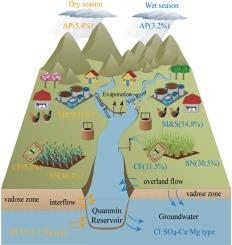季节硝酸盐输入驱动区域地表水-地下水相互作用、硝酸盐来源和转化的时空变化
IF 6.3
1区 地球科学
Q1 ENGINEERING, CIVIL
引用次数: 0
摘要
研究受人为氮输入影响的氮地球化学循环和水文过程,为水资源管理和水生生态系统保护的政策制定提供了新的见解。然而,目前对明确水文条件下硝酸盐(NO3 -)的来源贡献及其转化缺乏进一步的认识。由于它们的时空异质性,季节性人类活动变化对它们的影响尚未完全阐明。本研究结合水文地球化学分析、多种稳定同位素(δ15N-NO3 -、δ18O-NO3 -、δ2H-H2O和δ18O-H2O)、统计方法和贝叶斯同位素混合模型(MixSIAR),研究了中国丘陵区地表水-地下水相互作用、硝酸盐来源和循环过程。结果表明,受水岩相互作用和人为活动控制的地下水水化学类型具有季节性转变,从干季的HCO3-Ca·Mg向湿季的Cl·SO4-Ca·Mg转变,特别是在硝酸盐浓度高的地区。地下水的化学风化作用是由硅酸盐和碳酸盐岩的共同溶蚀作用驱动的。地下水对地表水的贡献率为73.5%,3月份为0.20 mm/d。5 - 10月总流量为407.03 mm。硝化作用是地下水氮转化的主要过程,而反硝化作用是局部的,主要发生在雨季。地下水中NO3 -的主要来源是土壤氮(SN;旱季为48.4±17.5%,雨季为30.5±11.6%),粪便和污水(M&;S;旱季为41.0±17.7%,雨季为54.8±11.7%)。M&;S贡献的空间分布与Cl-和SO42-浓度的升高相对应,特别是在雨季硝酸盐含量高的地点。这些结果表明,人为氮输入显著影响地下水水化学类型、硝酸盐来源和氮转化过程的时空变异。本文章由计算机程序翻译,如有差异,请以英文原文为准。

Seasonal nitrate input drives the spatiotemporal variability of regional surface water-groundwater interactions, nitrate sources and transformations
Addressing the nitrogen geochemical cycle, accompanied with hydrological processes, influenced by anthropogenic nitrogen inputs provides new insights on policymaking for water resource management and aquatic ecosystems protection. However, there is currently a lack of further understanding on the source contributions of nitrate (NO3–) and transformations under explicit hydrological conditions. Due to their spatiotemporal heterogeneity, the impact of seasonal human activity changes on them has not been thoroughly elucidated. This study combines hydrogeochemical analysis, multiple stable isotopes (δ15N-NO3–, δ18O-NO3–, δ2H-H2O, and δ18O-H2O), statistical methods, and a Bayesian isotope mixing model (MixSIAR) to investigate surface water-groundwater interactions, nitrate sources and cycling processes in a hilly region of China. Results showed that groundwater hydrochemical types, governed by water–rock interactions and anthropogenic activities, shift seasonally, from HCO3-Ca·Mg in the dry season to Cl·SO4-Ca·Mg in the wet season, particularly in areas with high nitrate concentrations. Chemical weathering in groundwater was driven by the combined dissolution of silicate and carbonate rocks. Groundwater contributed 73.5 % to surface water, with the rate of 0.20 mm/day in March. Total interflow was 407.03 mm from May to October. Nitrification emerged as the dominant nitrogen transformation process in groundwater, while denitrification was localized, primarily occurring during the wet season. The major sources of NO3– in groundwater were soil nitrogen (SN; 48.4 ± 17.5 % in the dry season and 30.5 ± 11.6 % in the wet season) and manure and sewage (M&S; 41.0 ± 17.7 % in the dry season and 54.8 ± 11.7 % in the wet season). The spatial distribution of M&S contributions corresponded to elevated Cl- and SO42- concentrations, particularly at sites with high nitrate levels during the wet season. These findings reveal that anthropogenic nitrogen inputs significantly influence the spatiotemporal variability of groundwater hydrochemical types, nitrate sources, and nitrogen transformation processes.
求助全文
通过发布文献求助,成功后即可免费获取论文全文。
去求助
来源期刊

Journal of Hydrology
地学-地球科学综合
CiteScore
11.00
自引率
12.50%
发文量
1309
审稿时长
7.5 months
期刊介绍:
The Journal of Hydrology publishes original research papers and comprehensive reviews in all the subfields of the hydrological sciences including water based management and policy issues that impact on economics and society. These comprise, but are not limited to the physical, chemical, biogeochemical, stochastic and systems aspects of surface and groundwater hydrology, hydrometeorology and hydrogeology. Relevant topics incorporating the insights and methodologies of disciplines such as climatology, water resource systems, hydraulics, agrohydrology, geomorphology, soil science, instrumentation and remote sensing, civil and environmental engineering are included. Social science perspectives on hydrological problems such as resource and ecological economics, environmental sociology, psychology and behavioural science, management and policy analysis are also invited. Multi-and interdisciplinary analyses of hydrological problems are within scope. The science published in the Journal of Hydrology is relevant to catchment scales rather than exclusively to a local scale or site.
 求助内容:
求助内容: 应助结果提醒方式:
应助结果提醒方式:


